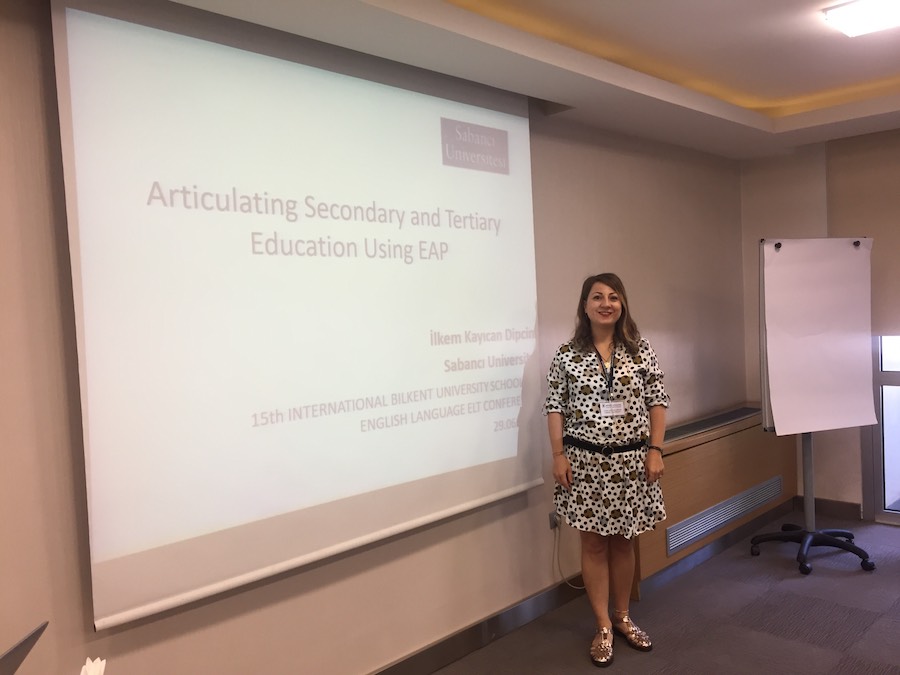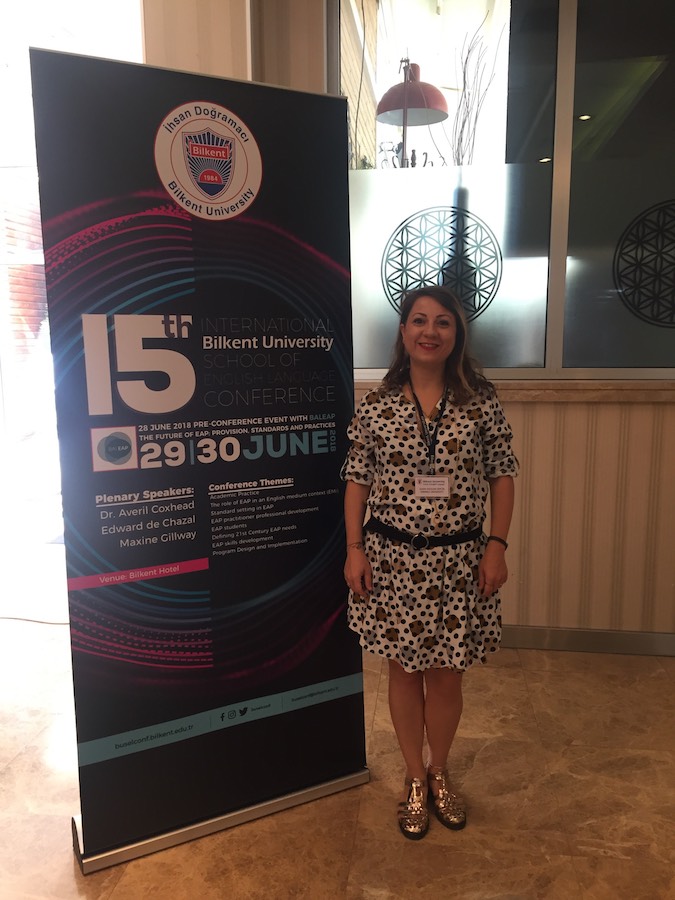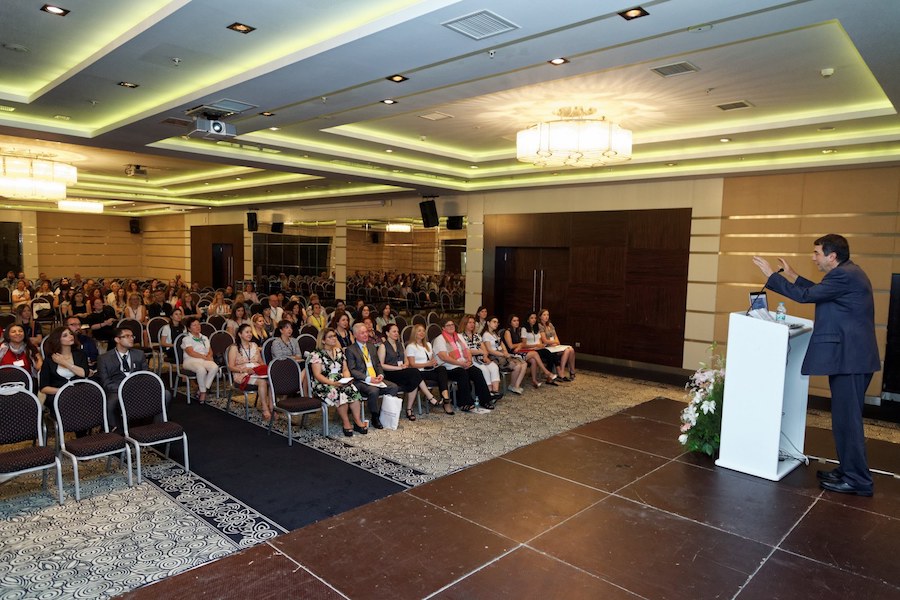15th International Bilkent University School English Language Conference
A Review by İlkem Kayıcan

The theme of this year’s conference was “The Future of EAP: Provision, Standards and Practices” with sub-categories including Academic Practice, EAP Students, Program Design and Implementation.
The day before the conference there was a pre-conference event with BALEAP (The Global Forum for EAP Professionals) “Going Global: perspectives on BALEAP”. The event mostly focused on the aims and projects of BALEAP and their increasing intention to go beyond the boundaries of the UK and have international partnerships with either institutions or individuals. Especially their Competency Framework for Teachers of English for Academic Purposes (2008) is worth consideration as it provides an alternative accreditation for professional development. The frame work can be accessible through this link: https://www.baleap.org/wp-content/uploads/2016/04/teap-competency-framew.... There 3 different scales to become a BALEAP accredited fellow: Associate Fellow, Fellow or Senior Fellow. These pathways and their requirements are explained on the website in detail. As it was mentioned in the pre-conference event there is an increasing number of universities that accept this accreditation during the employment process.
The Chair of BALEAP, Maxine Gillway from University of Bristol was based her talk on a very recent article by Hyland (2018) entitled “Sympathy for the devil? A defence of EAP.” In her presentation she discussed the strengths, weaknesses and the threats of EAP. Especially it was motivating to hear that there is a growing body of EAP including literature, knowledge and experience, collaborative and reflective practice, the fact that EAP professionals embrace being teachers not lecturers since they have the interactive and responsive relationship with their students. The part which Maxine addressed weaknesses and threats of EAP looked a bit vague to me that I feel the need to read Hyland’s article in order to access more clear picture of it.
When it comes to the conference the first plenary by Averil Coxhead from University of Wellington was quite interesting as she argued the importance of Academic Spoken Word List besides Academic Word List, it was obvious that she dedicated herself to the research on the vocabulary that is commonly used during lessons in EAP. She repeated the fact that when it comes to the 1st 1000 words of Academic Spoken Word List there are a lot of general vocabulary including “so, and, because”. Another interesting research she conducted was the use of academic vocabulary in Labs and tutorials, she said that students need to know 3,000 words well enough to communicate effectively. And the vocabulary that is used in labs and tutorials generally mismatch with the vocabulary that is taught in EAP/ESP books, she claimed that %63 of the vocabulary that were used in labs and tutorials were not in the books, which I guess an important point that needs to be considered. In her talk she referred to Nation’s book “Learning Vocabulary in Another Language” (2013) and highlighted the expected flow of vocabulary teaching as follows:
1.Planning 2. Strategy Planning 3. Testing 4. Teaching 5. Meaning focused input 6. Meaning focused output (summarizing, ranking activities)
It will be better to go through Nation’s book in order to understand these suggested steps to teach vocabulary.
My presentation was based on the project I have been running at Kadıköy Anadolu Lisesi for 2 academic semesters where I introduced Academic writing to 10th grade EFL high school students. As the project lends itself to the insufficient teaching of academic skills in secondary education, I tried to highlight the challenges of teaching academic writing to Turkish EFL students at tertiary level based on that lack. Referring back to my previous research I examined intercultural and cross-cultural rhetoric comparing the Western rhetorical traditions with Turkish writing conventions. In my presentation I shared the details and the stages I followed to run the project by introducing the rationale and process of LWA as I implemented it to teach EAP to high school students in the project. Besides, I described the ways how I added peer-tutoring aspect into the process by the contribution of our Route 4 students.
Another inspiring plenary talk was offered by Edward de Chazal. I was glad to see that his presentation also addressed the importance of introducing EAP in secondary education as the title was “The Future of EAP: Drilling down from Tertiary to Secondary EAP”. He started his talk by asking “In terms of EAP, what would you like your students to be able to do by the age of 18?” which was quite meaningful in Turkish EFL teaching context as well. By addressing the importance of offering academic skills in secondary school he pointed out the fact that there is no mention of secondary EAP in most of the EAP books in the market. He argued that teaching secondary EAP is important in terms of time and efficiency as students will have a working knowledge and will be at an advantage before their university studies, he added that a student who is introduced to EAP earlier will also have greater confidence in skills-building and be academically more successful. He referred to Millin& Millin’s study (2018) in South Africa which I think is a similar case to what we have experienced in Turkey. The universities assume that the students are familiar with the academic skills when they start their courses; however secondary schools students’ skills do not match the required skills to succeed at university. It is concluded that purposeful, scaffolded language and skills intervention programme at secondary level has significantly improved secondary school students’ English Language and academic literacy skills. At the end of his presentation De Chazal emphasized that there is a compelling need for secondary EAP and as EAP practitioners we need to influence this development.


